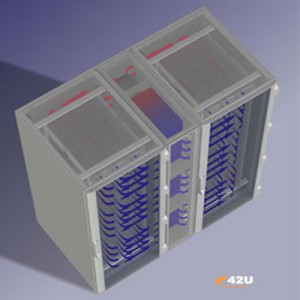Rack Cooling: Ambient Air vs. Liquid Cooling in Data Centers, Server Rooms, and Computer Rooms
 Heat is an important factor that significantly affects IT performance. Traditionally, most data center managers have relied upon the use of ambient air cooling solutions (alternating cool and hot rows) to meet their rack cooling needs. However, ambient air cooling solutions are often unable to handle high heat loads, are not targeted, and can be cost and energy inefficient. As power-intensive applications and server densities have increased, data center managers are seeking new ways to dissipate heat bi-products. Accordingly, the use of liquid cooling solutions has become an increasingly popular part of many data center cooling strategies.
Heat is an important factor that significantly affects IT performance. Traditionally, most data center managers have relied upon the use of ambient air cooling solutions (alternating cool and hot rows) to meet their rack cooling needs. However, ambient air cooling solutions are often unable to handle high heat loads, are not targeted, and can be cost and energy inefficient. As power-intensive applications and server densities have increased, data center managers are seeking new ways to dissipate heat bi-products. Accordingly, the use of liquid cooling solutions has become an increasingly popular part of many data center cooling strategies.
You can best mitigate heat issues if you have a thorough heat dissipation plan and invest in scalable cooling solutions. Below is a short overview of the two main approaches to data center cooling: ambient air cooling and liquid cooling.
Ambient Air Cooling
Data center ambient air cooling solutions typically involve the use of alternating aisles of cool air between racks. Cool air is supplied to the cold row through ducts under the raised data center floor supplied by computer room air conditioning (CRAC) units. The air is then exhausted from the back of the rack in the hot row and is pulled toward the ceiling using the building’s HVAC system. Other methods of cooling using ambient air include the use of fans mounted to the roof or rear door of a server rack and the use of rack-mounted and wall air conditioners. Ambient air cooling solutions are limited in their ability to handle high heat loads, as they typically are only able to effectively cool 5 to 10 kW per rack.
Liquid Cooling
Liquid Cooling Units are modular and temperature-neutral high-density cooling solutions that utilize LCP air/water heat exchangers and provide uniform, effective cooling for servers and IT equipment.
These units can be mounted at the rack base, or in a rack “side car”. Liquid cooling units have been used in industrial applications for years and have been recently re-introduced in data center applications to remove high levels of waste heat from server enclosures. The LCP units use a special horizontal airflow with constant temperature cold air provided at the front intake and hot air removed from rear of the enclosure for optimized cooling.
Features include up to 30kW cooling output with three cooling modules possible per equipment rack, and controlled variable speed fan and water flow based on actual heat load generated in a cabinet. You can place (or bay) liquid cooling units between two server racks. Liquid cooling units have become an increasingly popular choice for data center cooling, as they are better at managing the head loads created by high-heat blade centers than ambient air cooling solutions; are energy-efficient, as they remove waste heat with no temperature impact in the room and can be self-contained units; and can eliminate the need to construct an expensive raised data center floor.




